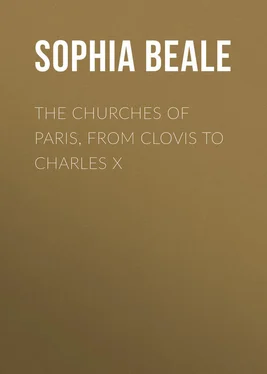Sophia Beale - The Churches of Paris, from Clovis to Charles X
Здесь есть возможность читать онлайн «Sophia Beale - The Churches of Paris, from Clovis to Charles X» — ознакомительный отрывок электронной книги совершенно бесплатно, а после прочтения отрывка купить полную версию. В некоторых случаях можно слушать аудио, скачать через торрент в формате fb2 и присутствует краткое содержание. Жанр: foreign_antique, foreign_prose, на английском языке. Описание произведения, (предисловие) а так же отзывы посетителей доступны на портале библиотеки ЛибКат.
- Название:The Churches of Paris, from Clovis to Charles X
- Автор:
- Жанр:
- Год:неизвестен
- ISBN:нет данных
- Рейтинг книги:3 / 5. Голосов: 1
-
Избранное:Добавить в избранное
- Отзывы:
-
Ваша оценка:
- 60
- 1
- 2
- 3
- 4
- 5
The Churches of Paris, from Clovis to Charles X: краткое содержание, описание и аннотация
Предлагаем к чтению аннотацию, описание, краткое содержание или предисловие (зависит от того, что написал сам автор книги «The Churches of Paris, from Clovis to Charles X»). Если вы не нашли необходимую информацию о книге — напишите в комментариях, мы постараемся отыскать её.
The Churches of Paris, from Clovis to Charles X — читать онлайн ознакомительный отрывок
Ниже представлен текст книги, разбитый по страницам. Система сохранения места последней прочитанной страницы, позволяет с удобством читать онлайн бесплатно книгу «The Churches of Paris, from Clovis to Charles X», без необходимости каждый раз заново искать на чём Вы остановились. Поставьте закладку, и сможете в любой момент перейти на страницу, на которой закончили чтение.
Интервал:
Закладка:
On the Good Fridays of each year the chapel scarcely sufficed to contain the crowds of sick persons who flocked to it from all parts of the city. All maladies were supposed to be curable through the virtues of the holy relics, but specially that known formerly as le mal caduc . At midnight the relic of the True Cross was exposed, and at the same moment the chapel was filled by the most fearful shrieks of these poor epileptics. The afflicted threw themselves about, foamed at the mouth, and fell into convulsions, invoking the aid especially of S. John the Baptist and S. Spire. The people were convinced every year that some wondrous miracle had been wrought; but the abuses connected with this nocturnal exposition were so great that, in 1781, Louis XVI. ordered it to be discontinued. The relics now shown in the Treasury of Notre-Dame, and exposed there during Holy Week, are said to be the veritable ones belonging to the Sainte-Chapelle; but the account of their preservation after the desecration of S. Denis is so miraculous (almost as much so as the original finding of the True Cross by S. Helena) that it requires a large amount of faith to believe in them. The reliquaries were of course all melted up, even Alexandre Lenoir could not save them. Those at Notre-Dame are quite modern, although somewhat of the same form.
Another custom peculiar to the chapel was the singing upon Christmas-day of the hymn " Noël ," in place of " O Salutaris Hostia ." The former had been originally a joy-song, welcoming the kings upon their entry into Paris; and thus, when our Henry V. entered the capital in 1420, and likewise Henry VI. in 1431, they were greeted with this exclamation.
The kings were not the only persons who profited by the virtues of the relics; the first president of the parlement was so far privileged that he could have them brought to him on his death-bed; and on Quinquagesima Sunday they were exposed at the central window of the chevet for the good of the public in the street. The châsse containing the relics had no less than ten locks, the keys thereof being in the custody of the kings until the reign of Louis XIII.; but while that monarch was at Lyons, a fire broke out in the chapel (26th July, 1630), and the doors of the châsse had to be broken open, a disaster which led to a change in the custodian, the president of the Chambre des Comptes being substituted for the sovereign. This worthy lived opposite; and it was also his duty to keep the relics clean, assisted of course by a vast number of other presidents and officials. It was the duty, or the privilege, of the kings to mount the little winding staircase at the side of the altar, and to exhibit the relics to the people gathered in the chapel below. S. Louis probably ofttimes walked up the steps on the left for this purpose (the right-hand staircase is modern); and on Good Friday, 1423, the Duke of Bedford, as regent of France for Henry VI., gave the blessing with the relics. In 1575, on the 10th July, a great theft took place of a portion of the cross which was frequently shown to the people (not the piece in the principal châsse ), and this in spite of six guards who " allans et venans toute nuict par icelle, tant pour la garde des sainctes reliques comme du lieu ." This was looked upon as a great calamity by many people; but by some of the incredulous was thought to be a feint of Henri III., who had permitted the relic to be sent to Italy as security for some money borrowed by that good daughter of the Church, the Queen-mother, Catherine de'Medici. In 1793 the destruction of the châsses and the dispersion of the relics was ordered by the Convention, and carried out by the notorious constitutional bishop Gobel. We cannot but lament the loss to art of these reliquaries; whether, reading over the list in full of the relics given by Canon Morand, we need sigh over their destruction, is another matter. They had swollen in number since S. Louis' time, and besides a portion of the true cross, the crown of thorns, and the lance, there was the rod of Moses, the cross of victory borne by the Emperors of the East, part of the purple mantle, the reed, and other instruments of the Passion, the linen with which Our Lord wiped the Apostles' feet, the sponge, the handcuffs, the holy blood, the Virgin's veil and a piece of her hair, an imprint of the face of Our Lord, a piece of the Holy Sepulchre, and the upper part of the head of S. John Baptist. All these objects, and one or two others which it is needless to mention, were enclosed in the reliquaries which either stood or hung in the great châsse . But other valuables were kept elsewhere. There existed up to the reign of Louis XVI. an elegant little sacristy upon the north-east side, having two storeys, in which were deposited deeds, charters, and gold and silver vessels for the use of the altar. In it was kept the splendid agate, now in the Bibliothèque Nationale, representing the Apotheosis of Augustus, which was absolutely presented to the people as a pax upon great festivals, until de Peiresc, Councillor of the Parlement of Provence, about 1619, discovered the mistake, and the so-called "Triumph of Joseph" became acknowledged to be the "Apotheosis of Augustus." A careful drawing of the cameo was made by de Peiresc's friend Rubens, which was engraved by Luc Vosterman of Antwerpen. It was called in the inventory of the chapel le Grand Camahieu and the Agate de Tibère ; it is, indeed, the largest known, and is of most exquisite workmanship. The whole family of the Cæsars is represented; some on earth, some in Heaven. The cracks in it are mentioned in the inventory of 1480, and it is described as: Item unum pulcherrimum camaut in cujus circuitu sunt plures reliquiæ. The cameo is supposed to have been one of the treasures brought by S. Louis from Constantinople. In 1343, Philippe VI. sent it to the Pope who had desired to see it, but Charles V. restored it to the chapel in 1379, and then the chapter made their possession certain, by engraving upon the socle: ce camaieu bailla à la Sainte-Chapelle du Palais, Charles cinquième de ce nom, roi de France, qui fut fils du roi Jean, l'an MCCCLXXIX . The Byzantine mounting, described by Tristan de Saint-Amant, was melted up when the cameo was stolen, in 1804: Car les quatres évangélistes sont représentés de part et d'autre du châssis ou tableau d'or, dans lequel cette pierre est enchâssée.
Another antique, an agate bust of Valentinian III., 6 6 It has also been designated as Titus, and Constantine the Great. It is without doubt of the 4th century (Chabouillet).
was metamorphosed into a S. Louis, and formed the crowning point of the precentor's mace. The clothing of this bust in silver-gilt drapery, the placing of a crown of thorns in the right-hand and a cross in the left, show the manner in which objects of Pagan art were adapted to Christian uses. That S. Louis should appear as a fat middle-aged man with a clean shaven face and cropped hair, was an anomaly of no consequence to the Mediæval artists. Another instance of the same naïveté is the bust of Caracalla which formerly figured as a S. Peter upon the cover of a book of the Gospels, now in the department of manuscripts. The cover is of silver-gilt, Christ crucified with the Virgin and S. John upon either side, the amethyst bust being placed at the foot of the cross. Upon the other side is Christ enthroned, and an imitation emerald which no doubt represents some precious gem that has since disappeared.
Some idea of the richness of the contents of the treasury may be formed by stating that the list of the images, vessels, reliquaries, crosses, &c., in the last inventory, taken in 1784, occupies twenty pages of Morand's book. Besides the objects already mentioned we read of a silver-gilt statue of S. Louis d'Anjou; a fragment of the cup of S. Martin; a portion of the tunic of S. Louis; an ivory Virgin, and thirty reliquaries of the 13th and 14th centuries. These were all conveyed to S. Denis on the 12th March, 1791, in a coach drawn by eight horses, and guarded by a chaplain and an officer of the king's household, who gave them over to the Benedictines, then still at the Abbey. In 1793 the relics trundled back to Paris in a procession which mimicked the former one, and after being taken to the Convention, they were melted up at the mint.
Читать дальшеИнтервал:
Закладка:
Похожие книги на «The Churches of Paris, from Clovis to Charles X»
Представляем Вашему вниманию похожие книги на «The Churches of Paris, from Clovis to Charles X» списком для выбора. Мы отобрали схожую по названию и смыслу литературу в надежде предоставить читателям больше вариантов отыскать новые, интересные, ещё непрочитанные произведения.
Обсуждение, отзывы о книге «The Churches of Paris, from Clovis to Charles X» и просто собственные мнения читателей. Оставьте ваши комментарии, напишите, что Вы думаете о произведении, его смысле или главных героях. Укажите что конкретно понравилось, а что нет, и почему Вы так считаете.




![Theresa Cheung - The Dream Dictionary from A to Z [Revised edition] - The Ultimate A–Z to Interpret the Secrets of Your Dreams](/books/692092/theresa-cheung-the-dream-dictionary-from-a-to-z-r-thumb.webp)







